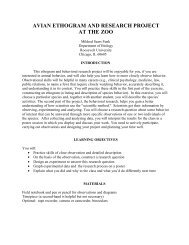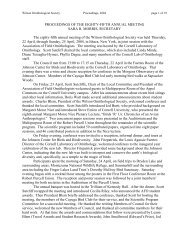Available now - Wilson Ornithological Society
Available now - Wilson Ornithological Society
Available now - Wilson Ornithological Society
Create successful ePaper yourself
Turn your PDF publications into a flip-book with our unique Google optimized e-Paper software.
WOS 2010 ~ ABSTRACTS p. 20<br />
21 Nest predation reduces benefits to early clutch initiation in an urbanizing landscape. Daniel P. Shustack,<br />
Massachusetts College of Liberal Arts, Biology Dept., North Adams, MA 01247, and Amanda D. Rodewald, School<br />
of Environment and Natural Resources, Ohio State Univ., Columbus, OH 43210<br />
Life history theory and empirical studies suggest that early breeding confers higher reproductive success, but the<br />
extent to which this advantage can be generalized to human-dominated systems is poorly understood. For example,<br />
although advanced reproductive phenology is well documented for birds breeding in urban systems, the fitness<br />
benefits (e.g., increased nest survival, greater number of fledglings) of early breeding remain largely unexplored.<br />
We studied the fitness consequences of reproductive timing for female Northern Cardinals (Cardinalis cardinalis) in<br />
forests within urbanizing landscapes of Ohio, USA between 2004-2007. In this heavily human-altered system, birds<br />
that bred early did not produce significantly more fledglings over the season compared to later-initiating individuals,<br />
although earlier breeders made significantly more nesting attempts and tended to produce more fledglings. The<br />
expected number of fledglings produced per successful nest remained constant over the course of the season at ~1.7<br />
fledglings per successful nest. However, nest survival rates improved dramatically as the season progressed.<br />
Because the probability of resighting breeding individuals in subsequent years was unrelated to clutch initiation<br />
date, we have no evidence that reproductive timing and effort affected survival. The absence of a clear benefit to<br />
early breeding appears to be a consequence of very high rates of nest predation earliest in the breeding season.<br />
22 Does habitat choice in the post-breeding season affect physiological condition of forest-interior songbirds Scott<br />
H. Stoleson U.S.F.S. Northern Research Station, Irvine, PA 16329<br />
Concern about declining populations of many songbirds of mature forest interiors has fueled opposition to evenaged<br />
management on public lands. However, recent work has shown that forest-interior species can be common in<br />
regenerating clearcuts during the post-breeding period, a critical time in avian life cycles. Whether such habitat<br />
shifts are commonplace, and whether birds’ habitat choices carry detectable consequences for physiological<br />
condition, remains unclear. I used constant-effort mist-netting in mature and young regenerating forests in<br />
northwestern Pennsylvania from July to September of 2005 to 2008 to test (1) whether forest-interior birds used<br />
early successional habitats disproportionally in the post-breeding season, and (2) whether such use affected<br />
physiological condition. Capture rates for forest interior species were significantly higher in early successional (12.4<br />
captures/100 net-hrs) than forest interior (5.3 captures/100net-hrs) habitats, although ratios differed among species.<br />
Further, birds captured in early successional habitats were more likely to have fat deposits (P = 0.05) and less likely<br />
to have ectoparasites (P





